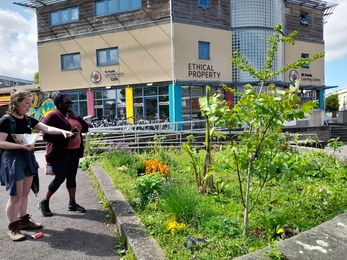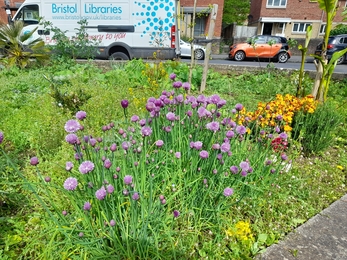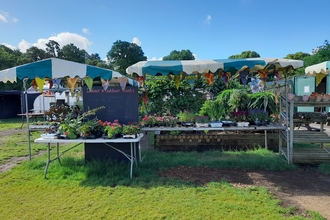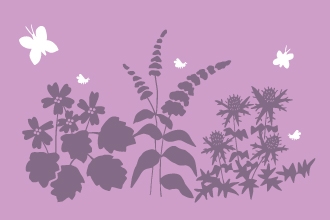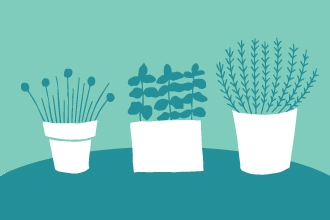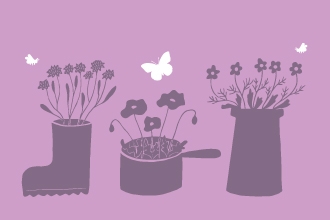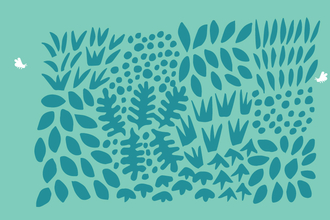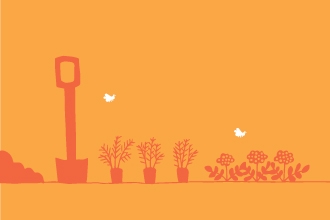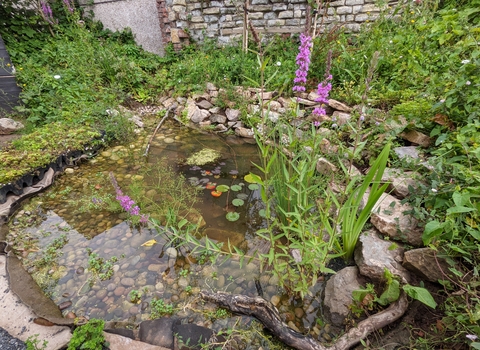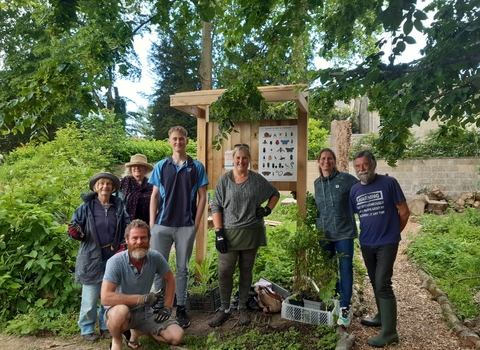
Sophie Bancroft
St Pauls Community Spirit and Plant Power with Judith
Team Wilder: Community Campfire, Summer - Judith in St Pauls (https://youtu.be/focLV9EcNIw)
Team Wilder Community Campfire
Judith has reclaimed and transformed several unloved, public spaces in St Pauls to tidy and brighten up the areas, encouraging a sense of pride, community spirit and connection with nature. This was particularly needed during the pandemic with restricted access to green spaces. Judith is community focused, resourceful and highly motivated. Judith received a visit from the Team Wilder Community Ecologist, advice aims included:
- Engaging the community with nature in community spaces.
- Brightening up public spaces and making them useful. Raising community spirit.
- Community gardening to include flowers, vegetables, herbs and wildflowers. Challenges of what to plant, how and where to plant it, plus resourcing the green spaces (plants, seeds, watering and weeding).
- Drought resistant plants that are suitable to grow.
- Vertical climbing plants for fences and walls.
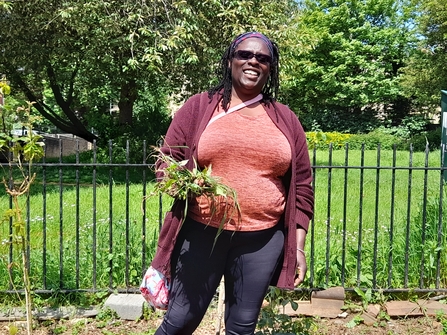
Sophie Bancroft
St Pauls Learning Centre
The green space just outside of St Pauls Learning Centre is being transformed. St Pauls Learning Centre is a community hub, which hosts events, gatherings, courses and creative activities. There is a cool café outside with seating area and lots of local families and residents pass by here on a daily basis, it is a busy area. The green space outside holds an opportunity to engage people with nature. Originally a community vegetable patch was suggested – but there were local concerns about it being too close to the road, so a community garden was created instead.
The community garden was created by the community – people donated plants to it and it is beautiful and healthy! They were given three apple trees, a banana tree, a walnut tree and many more flowers and plants.
In order to have permission to create this community garden, Judith had to agree to maintain it – which she cannot do alone! A community garden can be low maintenance but still needs to be looked after by the community – weeding, watering, planting. With rewards of a beautiful space, community spirit and achievement, fruit and berries for passers-by and decreasing the chances of litter.
Raising interest: Seeing people like Judith working in community spaces raises interest with people who pass by, chat about what she is doing and share knowledge about growing and the local area – making connections and encouraging a pride in the space.
Judith encourages a no dig system and received the following advice from the Team Wilder Community Ecologist to realistically help manage and maintain this space, maximising potential for people and wildlife engagement.
TWEAS Advice:

Esther Frizell-Armitage
The Team Wilder Ecological Advisory Service (TWEAS) gave the following recommendations: Grow Wilder is a good wildflowers supplier.
The community garden receives full sun and therefore I suggest that you plant species that can cope in these conditions. I recommend that you choose flowers such as bird’s-foot trefoil, yarrow, oxeye daisy, common knapweed, purple selfheal, common toadflax, white campion, field scabious and musk mallow.
You may want to grow some herbs along the front of the plot too (alongside the footpath). I suggest growing herbs such as sage, lavender, wild marjoram, oregano, chamomile, mint and basil as well as any others that are suited to full sun.
The plot is approximately 29m2 and it is recommended that 5-7 plug plants are planted per m2. Therefore this indicates how many plug plants will be needed to fill the space. The existing plants will need to be taken into account though and so the new plug plants can fill the remaining space.
Rose Memorial Garden
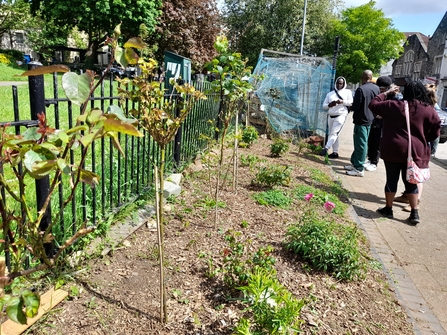
Sophie Bancroft
During the pandemic access to green space was severely restricted. Many residents in St Pauls has no access at all and felt very isolated, especially the residents in flats. Access to green space is a basic right that everyone should have. Judith embraced the power of plants to help herself and her community to have more green space, to tidy up and brighten the area, to raise community spirit, give children somewhere safe to play and learn, a place to remember and pay respect to those who were lost during the stressful times of the pandemic.

Sophie Bancroft
Memorial Rose Garden advice from TWEAS (Team Wilder Ecological Advisory Service)
Vertical space There is a fence along the entire north-western boundary and I recommend that you make use of this vertical space by growing more climbing plants. You currently have some climbing roses that will really benefit wildlife. I also suggest honeysuckle, passion flower, hops, ivy, star jasmine, wisteria, clematis, climbing roses or dog rose.
Wildflowers and other plants The roses can be underplanted with other colourful plants that grab the attention of the public and also really benefit wildlife. The plot receives full sunshine and need to be drought resistant (as watering the plants can be difficult). It is best to include plants that flower at different times, to provide a yearly resource for pollinators. Learn more about benefiting pollinators, which details monthly blooms to ensure a year round resource for pollinators.
The species recommended above for St Pauls Learning Centre Community Garden will also be suitable here as there are similar conditions between plots. Other species could also be planted to give the plot some vibrant colour throughout the seasons, before, during and after the roses bloom. For example:
- Catmint : flowers over a long season (from late spring to late summer).
- Lavender: flowers in early spring.
- Marigolds: flowers from summer to autumn. Marigolds also help the growth of roses and vegetables by deterring pests (like aphids)!
- Globe thistle: late-summer flowering plants.
- Geraniums: flower from spring/early summer to autumn.
- Alliums: flower in May and June. Some species have later flowering (July and August).
- Yarrow: flowers in June to August and thrive in full sun .
- Chives and onions: it has been found that chives and onions make roses more fragrant when planted nearby!
- Sage: prevent aphids from feeding on the roses.
- Heather: thrives in full sun and you can find different varieties that flower in winter.
- Winter aconites: flower in early February.
Mini pond Water really helps to draw in wildlife to an area, even if it is just a small amount. I recommend a mini pond in the corner of the rose garden to benefit wildlife, such as invertebrates and amphibians. All you need is an old container (e.g. pot, washing up bowl etc.), some gravel and rocks and maybe a few pond plants.
Ground Routes Foundation have created these vegetable patches on community land, at either side of the Memorial Rose Garden, to benefit the local residents, as well as transforming a local play area for local children. They involved children, which made them look at life differently, for the better, to learn where food comes from and that they can grow their own food. Tego/Wayne spoke passionately about what they had done in these green spaces to benefit everyone. Working on these projects gave pride and ownership in their neighbourhood. Here is some advice:
TIP: Give vegetables the correct space to grow to get a higher yield and reach their full potential.
People care about this vegetable plot and want it to do well. Food taken from this plot was also cooked for the community, bring people together. The values are to grow food for the community and bring people together, learning as they go together.
Barley has been involved in growing potato, yam, pumpkins, lettuce, corn and much more. He also shared some great advice:
TIP: Use a mirror to help reflect the sun towards the plants and get more sun.
TIP: Use copper tools – the copper touches the ground and helps deter the snails.
CHALLENGE: Watering the plants is a problem in the summer. They have a water butt and also recommended using upside down water bottles, to release the water slowly and therefore last for longer.
CHALLENGE: Rubbish has also been an issue – dangerous and sharp items have been retrieved from the community vegetable plots. The areas are sectioned off, especially during carnival. Locals are encouraged to get involved to welcome pride and community ownership of the area. Barley has also been trained by Bristol City Council in heath and safety.
Seventh Corner Community Garden

Sophie Bancroft
This transformed, beautiful space is more than a community garden space – it is a way of reaching the local residents to show what’s possible in a space like this. Planting happiness – seventh corner holds the potential to case a ripple effect in local gardens and other community spaces. There is a lot packed into this green pocket of inspiration in the Seventh corner of St Pauls.
In this compact space, Judith has started or has plans for:
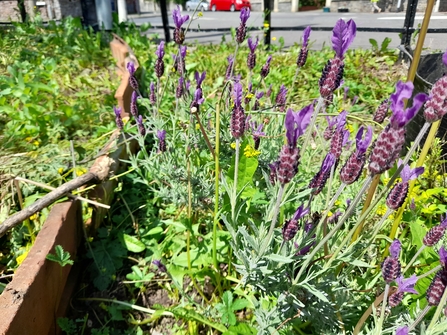
Sophie Bancroft
Wildflower patch
Here are recommendations from the Team Wilder Community Ecologist
The corner of the plot is partially shaded by the neighbouring house and wall. I recommend that you plant or sow some shade-tolerant wildflowers (a generic seed mix will also be suitable). There are a number of suppliers that sell shade-tolerant flowers such as this mix from Habitat Aid or more of a generic wildflower seed mix such as this one from Emorsgate Seed. Also have a look at what other suppliers offer (within the suppliers section below).
Species that would suit the plot are common knapweed, garlic mustard, agrimony, yarrow, cow parsley, wild carrot, wood avens, oxeye daisy, selfheal, wild strawberry, fox gloves, red campion and white campion.
Meadow establishment and management
Spring (including May) or autumn is the best time to sow wildflower seed. Before you want to sow the seed, ensure that you mow the grassland very short and collect the arisings immediately so that the nutrients don’t leach back into the soil (wildflowers grow well in low nutrient soils). Then create at least 50% bare ground by raking or using a hand scarifier. Sow the seeds in to the soil (you could use some sand if available as it helps to distribute the seed better).
Each supplier details management techniques for the chosen seed mix. These providers also detail suitable management techniques for the chosen seed mix.

St Pauls Seventh Corner Community Garden (c) Sophie Bancroft
What to include in a community garden
- What does the community want? This is will increase chances of local residents taking ownership and getting involved in watering, weeding, planting, keeping an eye out and enjoying the space. Eg Kids like sunflowers!
- Practical: Compost area, water butt, tool storage, ask for free plants and seeds. Where is this space connected to and is anything growing there?
- Veg patch - great to give to the community.
- Wildflower patch - beautiful and pollinator friendly.
- Climbing plants/ vertical growing - to maximise space.
- Bug hotel.
- Bird and bat boxes. Hedgehog home where possible.
- Dead hedges - habitat space, practical to section off areas and uses materials on site.
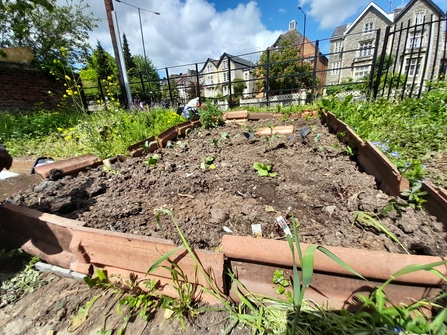
Sophie Bancroft
Veg Patch
Grown by the community for the community - beetroot, kale, bok choy, cabbages, sprouts, runner beans, celeriac. Judith has gone for a no-dig policy where possible, to maximise the soil health.
Challenge: Getting people involved and watering the plants on a regular basis
Solution: Grow what the local community wants, such as sunflowers for the local kids. Word of mouth is the best way to get people involved, so Judith speaks to people as she’s working there.
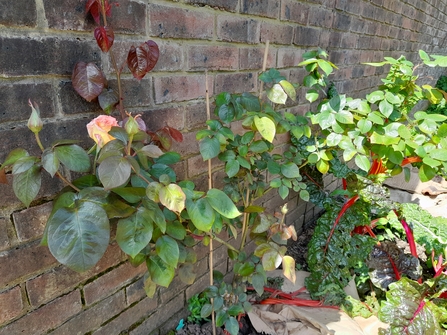
Sophie Bancroft
Climbing plants up the wall
Similar to the rose garden, I recommend that you make use of the vertical space by growing more climbing plants. Please see the list above that was recommended for the rose garden as these would also be suitable.
Bug hotel
I recommend that a bug hotel is created and installed within the less disturbed area. This guidance includes a step-by-step guide to making a bug hotel. Materials include wooden pallets, bricks, dead leaves, woody material such as sticks/twigs etc.
I also recommend that you put a planter on top and plant some wildflowers for pollinators too!
Bird and bat boxes
Bird boxes could be installed on the wall on site. Bird boxes should go on the northern or eastern elevations. The wall is east facing and so this is suitable for bird boxes. The resources below have some suppliers (e.g. NHBS and Wildcare) that sell these boxes.
I recommend that you either get a sparrow terrace (sparrows nest in family groups so they like to have 2 or 3 different compartments to nest in close by to each other) or you could put up a more generic bird box for garden birds.

Sophie Bancroft
Resources

(C) Hannah Bunn
Be part of Team Wilder
All actions for nature collectively add up and creates life for people and wildlife.
Share your actions for nature, like Tom by sharing and tagging @avonwt on social media and
Log your actions for nature on the map

